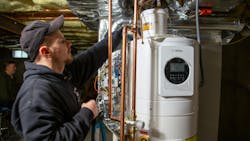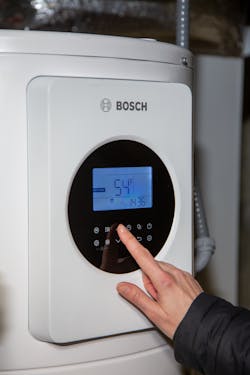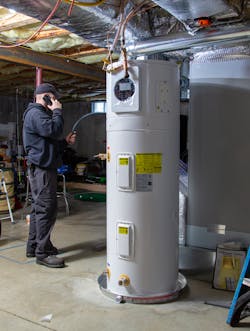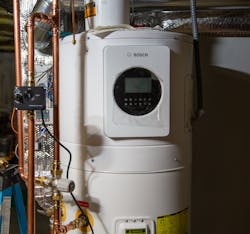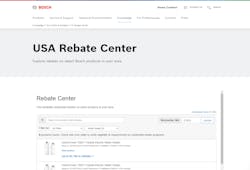According to Energy Star, 2023 was a record year for heat pump water heaters, with 190,000 units shipped. That’s a 35% increase over 2022 and exceeds natural gas tank water heaters in terms of both 2023 unit shipments and market share.
Heat pump water heater shipments have grown steadily since Energy Star first certified them in 2009, with the recent sharp increase due to a variety of factors. One major driver is the raft of rebates, tax credits, and other financial incentives from municipalities, utilities, states, and the federal government. Another reason is that heat pump water heaters benefit from the growing number of state and municipal environmental regulations that limit any type of gas appliance in new homes. Finally, some builders — such as Clayton — are making heat pump water heaters standard in new homes.
Those are a few major reasons why heat pump water heaters are here to stay. That’s good news for plumbers because it gives them a compelling new type of product to offer customers who want to reduce their utility bill, carbon footprint, or both.
Homeowners who want to replace a tank water heater with an electric tankless model for greater energy efficiency but can’t because their panel lacks the necessary capacity. A heat pump water heater avoids the need for expensive panel upgrades because it’s so energy efficient.
For example, the Bosch GreenTronic 7000 T uses just 1 kW of electricity to generate 3.75 kW of heat. That’s three to four times more efficient than a traditional tank electric water heater and enables the GreenTronic to use the old unit’s existing 30 A service.
The GreenTronic achieves this efficiency via features such as variable-speed fans, a microchannel condenser, and four heating modes. The default mode is “economy,” which generates 3.75 kW of heat for every 1 kW of power. Two other modes use electric heating elements to supplement the heat sourced from the ambient air. The fourth and most efficient mode is “heat pump only,” which uses no electric heating elements. The homeowner can choose to activate those modes — manually or automatically — when demand is unusually high, such as a house full of guests showering at the same time.
Installation Best Practices
To maximize efficiency, heat pump water heaters should be installed in locations where the ambient air temperature stays between 37°F (3°C) and 109°F (43°C). In hot climates such as Florida and Arizona, traditional water heaters are often installed in garages because the risk of frozen pipes is very low. An unconditioned garage is ideal for a heat pump water heater because it provides an ample supply of hot air.
In colder climates, traditional water heaters are installed in basements or utility rooms on the main level. Heat pump water heaters have the additional benefit of providing dehumidification and cooling in those locations. For example, the GreenTronic delivers a half-ton of cooling capacity. Depending on the home and climate, dehumidification can provide additional savings by eliminating the need for a standalone dehumidifier and the electricity to run it. The cooling effect is even more beneficial in hotter climates and thus gives homeowners one more reason to upgrade to a heat pump water heater.
Utility rooms typically are as small as possible to maximize living space. Make sure that the room provides enough airflow to meet the manufacturer’s recommendations, such as 700 cubic feet in the case of the GreenTronic. If the room isn’t big enough to provide that, two options are installing a duct adapter or replacing the door with a louvered model to increase airflow.
Installations near living spaces also highlight the importance of choosing a heat pump water heater that’s quiet. For example, the GreenTronic operates at just 49 dBA, which is comparable to better-quality refrigerators. Dehumidification can play a role here, too, by eliminating the noise of a standalone dehumidifier, which can run 60 to 70 dBA.
Drainage is another important consideration because heat pump water heaters produce condensation. The daily amount varies based on factors such as the humidity level, but the bottom line is that it’s not acidic and thus can go into the existing floor drain or condensate pump. It should not be drained into the overflow pan.
Easy Does It
For plumbing contractors, ease of installation is a key consideration when deciding which brand of heat pump water heater to offer. In addition to the ability to reuse an existing 30 A connection, look for heat pump water heaters that use terminal blocks, which eliminate the need for wire nuts and clips that can break.
The water connections should be mounted on the side rather than the top. The heat pump makes the water heater taller than traditional units, so side-mounted connections provide more installation flexibility.
Another key consideration is serviceability. Unlike traditional tank and tankless units, heat pump water heaters use refrigerant, which plumbers rarely work with. That’s why it’s important to focus on manufacturers whose warranty policy is to simply replace the entire water heater when refrigerant is the issue.
Finally, look for manufacturers that make it easy for contractors to educate customers about all of the available rebates and tax credits. For example, Bosch has a website where simply entering the model number and location provides a comprehensive list of federal, state, utility, and municipal incentives, saving time for contractors and money for their customers.
Sponsored by:
